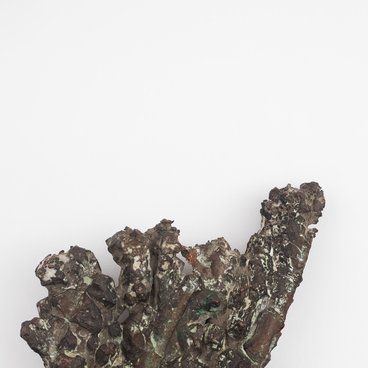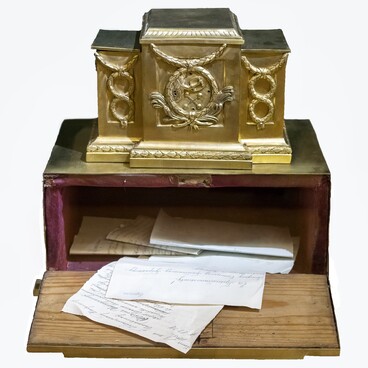The word “Lenin” above the entrance of the Mausoleum on Red Square in Moscow is made out of red quartzite. The entrance pedestals are and the upper part of the building are also clad in quartzite. Red quartzite is mined only in one place in Russia — in the village of Shoksha on the western shore of Lake Onega, 65 kilometers south of Petrozavodsk.
The cube from the National Museum of the Republic of Karelia was made at the Onega mining administration company in the 1950s. At different times, red quartzite was called the “Shoksha stone”, “Shoksha red porphyry” or “Shokshan porphyry”. It is a hard stone of rare crimson color, which consists of compressed granules of quartz. Quartz makes about 88–95% of the rock. Iron compounds make the quartzite look red.
The Shoksha quartzite started to be mined on industrial scale in the 18th century. In those times, the mined stone was called Shokhan porphyry or royal stone. The reason of it was that this stone was similar to the Egyptian porphyry in color.
It is difficult to process red quartzite stones. However, after grinding and polishing they could last for at least six hundred years and keep their hardness, gloss and color. Because of its beauty, durability and high cost, this mineral was used in St. Petersburg only for decoration of palaces, cathedrals and monuments. The frieze of Saint Michael’s Castle on the southern facade of the building was made out of quartzite, as well as the interior decorations of The Great Hermitage and the Winter Palace.
You can find red quartzite in St. Isaac’s Cathedral and Kazan Cathedral in St. Petersburg. In both buildings, it was used to make the steps to the altars. In St. Isaac’s Cathedral, it was used at the base of the iconostasis and on the cornice crowning the stone decor of the entire interior. The mineral was also used at the base of the monument to the Russian Emperor Nicholas I in St. Isaac’s Square in St. Petersburg. 47 blocks of Shoksha quartzite were mined and delivered to Paris for the construction of Napoleon Bonaparte’s sarcophagus in 1847 with the permission of the Russian Emperor Nicholas I. The French architect Louis Visconti was the author of the sarcophagus.
The cube from the National Museum of the Republic of Karelia was made at the Onega mining administration company in the 1950s. At different times, red quartzite was called the “Shoksha stone”, “Shoksha red porphyry” or “Shokshan porphyry”. It is a hard stone of rare crimson color, which consists of compressed granules of quartz. Quartz makes about 88–95% of the rock. Iron compounds make the quartzite look red.
The Shoksha quartzite started to be mined on industrial scale in the 18th century. In those times, the mined stone was called Shokhan porphyry or royal stone. The reason of it was that this stone was similar to the Egyptian porphyry in color.
It is difficult to process red quartzite stones. However, after grinding and polishing they could last for at least six hundred years and keep their hardness, gloss and color. Because of its beauty, durability and high cost, this mineral was used in St. Petersburg only for decoration of palaces, cathedrals and monuments. The frieze of Saint Michael’s Castle on the southern facade of the building was made out of quartzite, as well as the interior decorations of The Great Hermitage and the Winter Palace.
You can find red quartzite in St. Isaac’s Cathedral and Kazan Cathedral in St. Petersburg. In both buildings, it was used to make the steps to the altars. In St. Isaac’s Cathedral, it was used at the base of the iconostasis and on the cornice crowning the stone decor of the entire interior. The mineral was also used at the base of the monument to the Russian Emperor Nicholas I in St. Isaac’s Square in St. Petersburg. 47 blocks of Shoksha quartzite were mined and delivered to Paris for the construction of Napoleon Bonaparte’s sarcophagus in 1847 with the permission of the Russian Emperor Nicholas I. The French architect Louis Visconti was the author of the sarcophagus.



